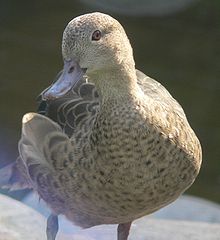Amber duck
| Amber duck | ||||||||||||
|---|---|---|---|---|---|---|---|---|---|---|---|---|

Male Bernier Duck ( Anas bernieri ) |
||||||||||||
| Systematics | ||||||||||||
|
||||||||||||
| Scientific name | ||||||||||||
| Anas bernieri | ||||||||||||
| ( Hartlaub , 1860) |

The Bernier's Teal ( Anas bernieri ) is a bird art from the family of ducks . Today it is one of the rarest water birds in the world and is considered endangered.
The species, which probably developed from the representatives of the white-throated ducks due to the long geographical isolation in Madagascar , was discovered in 1850 and scientifically described for the first time in 1860. The Andaman white-throated duck , to which it looks very similar, is considered to be a bridge to the Bernese duck .
Appearance
Amber ducks show no pronounced sexual dimorphism . In both sexes, the entire plumage is ocher-colored to red-brown. While the male's beak and feet are more reddish in color, the female's are brown.
Chicks have a black-brown down dress on the top , the belly is feathered golden yellow. The bill and legs are colored black-brown.
Distribution, habitat and existence
The original habitat of the Bernier Duck covers the western part of Madagascar . At the time of its discovery and scientific description as an independent species, it was found in small groups in swamp lowlands and along water rivers. Today their natural occurrence is limited to the Bemamba lake not far from the west coast there. The lake is used intensively for rice cultivation; only part of the lake is still in its original state. In 1950, a fish species was released in the lake as food fish, which greatly reduced the number of aquatic plants. Due to the intensive agricultural use, the local population also regularly burns down the sedge in which the Bernese duck nests. Since the Bernese duck has no protection status in Madagascar, it is also hunted.
In 1993 the total population was estimated at only 500 individuals.
Way of life
Little is known about the way of life of the Bernese ducks. It is believed to breed before and after the rainy season. The nests are in the sedge near the water.
The average clutch count is six eggs.
Measures to preserve the species
Since the amber duck is a duck with rather inconspicuous plumage, it has never become particularly popular in ornamental poultry keeping. However, in the 1990s, some individuals were moved to the Jersey Zoo for conservation breeding. In the meantime, Bernese ducks are also kept and bred in the Walsrode Bird Park , Cologne Zoo and the “ Masoala Rainforest ” of Zurich Zoo . Bernier ducks are considered easy to breed, so there is hope that the species will be preserved through zoo breeding, similar to the Hawaiian geese.
literature
- T. Bartlett, Ducks And Geese - A Guide To Management , The Crowood Press, 2002, ISBN 1-85223-650-7
- Hartmut Kolbe; Die Entenvögel der Welt , Ulmer Verlag 1999, ISBN 3-8001-7442-1
Web links
- Anas bernieri in the endangered Red List species the IUCN 2008. Posted by: BirdLife International, 2008. Accessed on December 18 of 2008.
- Videos, photos and sound recordings of Anas bernieri in the Internet Bird Collection
